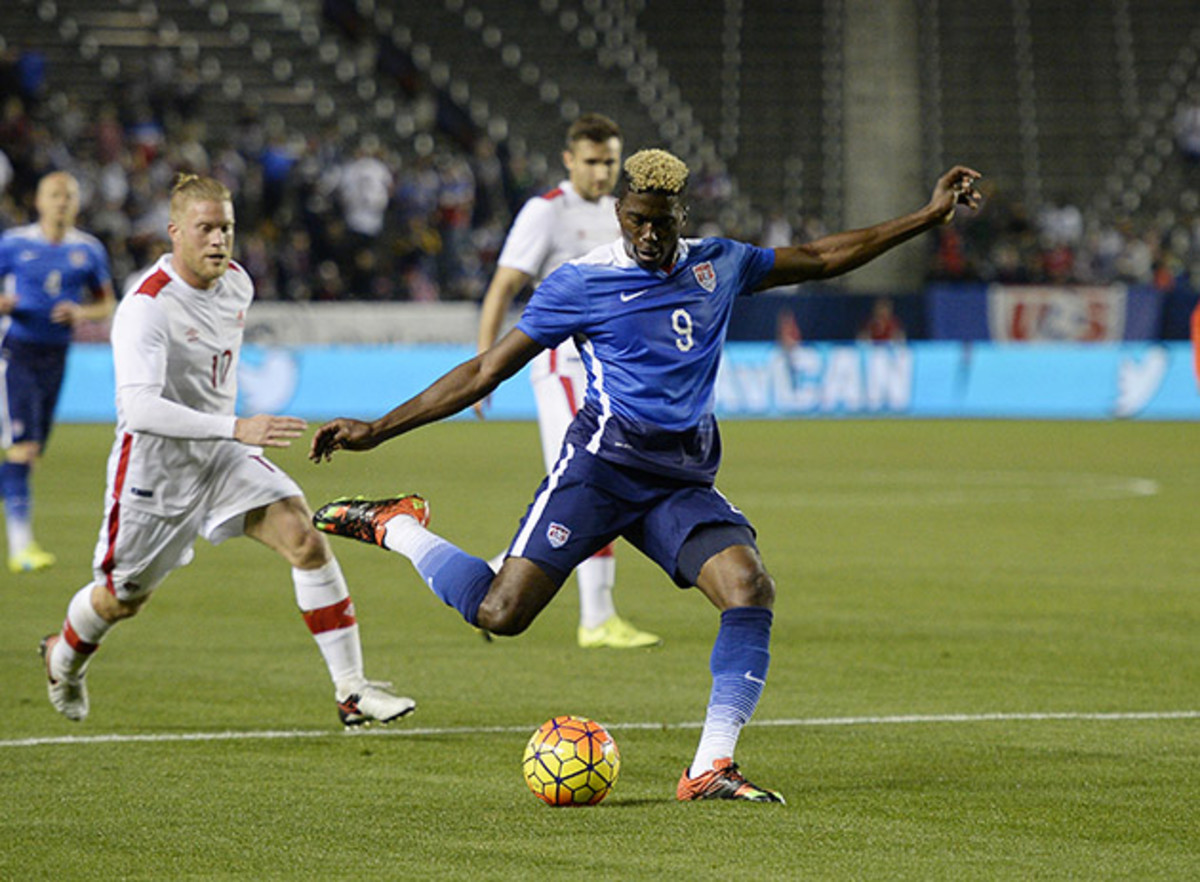How Gyasi Zardes trains ball control and first touch

After the Los Angeles Galaxy finished its team practice on Wednesday, most of the players wandered back into the Stubhub Center to eat lunch and watch the UEFA Champions League quarterfinals. Galaxy assistant Head Coach Dave Sarachan, however, wasn’t done with a couple of his strikers.
Sarachan stood on the player’s right side of the goal, sending balls in to Galaxy first team rookie Ariel Lassiter and U.S. men’s national team striker Gyasi Zardes, who were set up at the edge of the penalty box; before sending each of the 10 balls he distributed between the two, Sarachan called out which sector of the empty goal he wanted them to send it.

“What we did today was set up a few different movements that would allow him different angles, moving and turning with the ball, with an emphasis on placement rather than power in terms of the final touch,” Sarachan says. “In terms of the evolution of Gyasi as a striker, he still relies sometimes on the notion that it has to be hit hard.”
To Sarachan’s point, Zardes attempted a first touch on a ball off of a weird bounce, sending it so far over the crossbar that it cleared the net set up as the last line of defense for wayward strikes, and sailed across the parking lot. How to control his strength is a lesson that the 24-year-old Zardes is still learning, but his work rate, which is labeled as top-class by multiple coaches and players on the team, has led him to a secret training method that is helping Zardes’ first touch become second nature.
• MORE EDGE: Timbers look for balance in conditioning and over-training
Zardes has used the TOCA first touch training system, which was developed by former USMNT member Eddie Lewis, since the beginning of 2014. He gives it a lot of credit when it comes to the strides that he has made for club and country over the past two seasons. The TOCA, which looks like a motorized push lawnmower with a spiral of soccer balls on it, fires soccer balls based on height and direction-specific orders that Zardes gives with his iPhone. At its fastest, TOCA can fire balls every two seconds, a pace which Zardes says he can now keep up with when working on his first touch rapid fire style, which he does on occasion. In general, he favors the slower, but still demanding, four-second interval.
“Two seconds per ball is tough, but I can do it now with a lot less trouble than when I first began,” Zardes says. “In that way I can really feel the progress.”
In a perfect world for his L.A. Galaxy and USNMT, Gyasi Zardes is an important player. Recently, both squads have leaned on him to be more than he ever has been for them. After the U.S. Men lost the first leg of their World Cup qualifiers to Guatemala, it was Zardes’s run that, with a little luck, paved the way for Clint Dempsey’s opening goal in the pivotal rematch. The Galaxy offense was off to a rough start even before Robbie Keane went down with an injury, but Zardes has answered the call there as well. Zardes was the most dangerous player for L.A. in its scoreless tie against Vancouver over the weekend and his brace was the margin of a 3-1 victory for the Galaxy over San Jose before that.

The TOCA hasn’t only helped Zardes’ finishing; it also pushes him to improve his close-quarters ball control. Zardes adopted a drill that he picked up at the TOCA facility, which puts athletes in octagons of various sizes (two square feet of space, four square feet of space, etc.) and makes the ability to handle the ball within that space as important as handling it at speed.
“Getting comfortable controlling the ball in those tight spaces is one of the first things I was able to translate into the game,” says Zardes. “The first touch is important everywhere on the field, not just in front of goal. It’s helped me understand spacing in terms of my teammates as well.”
Inside Hope Solo's innovative goalkeeper training and fitness
The Galaxy have a TOCA machine on their practice field, but Zardes can’t remember the last time that he saw it. That’s probably because he’s seen his own so many times since that point. Zardes says he trains with his machine during the offseason for an hour, three times a week. During the season, he ratchets that up to four or five times a week. Zardes sets up the TOCA on the left side of his house, which has a side yard about the size of an official penalty box.
“I like to start off with high speed on the ground, just to get your feet ready and just control the ball. I do sometimes engage it at the two-second interval for rapid one touch training. But most of all I like to go aerial with it at various speeds, because in games you find yourself with the ball in the air most of the time, and the speed at which it’s getting there is anyone’s guess, but that’s what I’m trying to simulate.”
Working three to five hours a week on top of practice for the past two years on his first touch, second touch, spacing and finishing, has helped Zardes refine his control over his natural strength, an element of his game that Sarachan and the rest of the Galaxy coaching staff have really put a focus on. The assistant coach was unaware of his striker’s extra reps, but wasn’t surprised to learn of them.
The SI Extra Newsletter Get the best of Sports Illustrated delivered right to your inbox
Subscribe
“I didn’t even know he did that on the side, but it tells you a lot about him and the motor that he has. I usually try to work him out extra because I know that he could have gone another hour without much issue,” Sarachan said. “Any tool that allows you to work on technique is good. The next step of applying that in a game is another conversation, but for young players [like Zardes] it’s 100% positive.”
In 2014, when Zardes first started using the TOCA, he was able to showcase a refined touch by finishing chances created by the talent around him. The Galaxy offense hasn’t played to that level so far this season, and if it does, Zardes will have to do more than finish chances; he’ll have to create them as well. Zardes and the Galaxy alike hope that his work on the training field and in his side yard can help him take that next step sooner rather than later.
